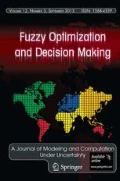Abstract
We prove that three independent fuzzy systems can uniformly approximate Bayesian posterior probability density functions by approximating the prior and likelihood probability densities as well as the hyperprior probability densities that underly the priors. This triply fuzzy function approximation extends the recent theorem for uniformly approximating the posterior density by approximating just the prior and likelihood densities. This approximation allows users to state priors and hyper-priors in words or rules as well as to adapt them from sample data. A fuzzy system with just two rules can exactly represent common closed-form probability densities so long as they are bounded. The function approximators can also be neural networks or any other type of uniform function approximator. Iterative fuzzy Bayesian inference can lead to rule explosion. We prove that conjugacy in the if-part set functions for prior, hyperprior, and likelihood fuzzy approximators reduces rule explosion. We also prove that a type of semi-conjugacy of if-part set functions for those fuzzy approximators results in fewer parameters in the fuzzy posterior approximator.
Similar content being viewed by others
References
Bickel P. J., Doksum K. A. (2001) Mathematical statistics: Volume I, 2nd ed. Prentice Hall, Englewood Cliffs, NJ
Billingsley P. (1995) Probability and measure, 3rd ed. Wiley, London, p 269
Carlin B. P., Louis T. A. (2009) Bayesian methods for data analysis, 3rd ed. CRC Press, Boca Raton, FL
DeGroot M. H. (1970) Optimal statistical decisions. McGraw-Hill, New York, NY
Folland G. B. (1999) Real analysis: Modern techniques and their applications, 2nd ed. Wiley-Interscience, New York, NY
Hogg R. V., McKean J. W., Craig A. T. (2005) Introduction to mathematical statistics, 6th ed. Prentice Hall, Englewood Cliffs, NJ
Jin Y. (2000) Fuzzy modeling of high-dimensional systems: Complexity reduction and interpretability improvement. IEEE Transactions on Fuzzy Systems 8(2): 212–221
Kosko B. (1992) Neural networks and fuzzy systems: A dynamical systems approach to machine intelligence. Prentice Hall, Englewood Cliffs, NJ
Kosko B. (1994) Fuzzy systems as universal approximators. IEEE Transactions on Computers 43(11): 1329–1333
Kosko B. (1995) Optimal fuzzy rules cover extrema. International Journal of Intelligent Systems 10(2): 249–255
Kosko B. (1996) Fuzzy engineering. Prentice Hall, Englewood Cliffs, NJ
Kosko B. (2004) Probable equality, superpower sets, and superconditionals. International Journal of Intelligent Systems 19: 1151–1171
Lee I., Kosko B., Anderson W. F. (2005) Modeling gunshot bruises in soft body armor with adaptive fuzzy systems. IEEE Transactions on Systems, Man, and Cybernetics 35(6): 1374–1390
Mitaim S., Kosko B. (1998) Neural fuzzy agents for profile learning and adaptive object matching. Presence 7(6): 617–637
Mitaim S., Kosko B. (2001) The shape of fuzzy sets in adaptive function approximation. IEEE Transactions on Fuzzy Systems 9(4): 637–656
Mitra S., Pal S. K. (1996) Fuzzy self-organization, inferencing, and rule generation. IEEE Transactions on Systems, Man, Cybernetics—A 26(5): 608–620
Munkres J. R. (2000) Topology, 2nd ed. Prentice Hall, Englewood Cliffs, NJ
Osoba, O., Mitaim, S., & Kosko, B. (2011). Bayesian inference with adaptive fuzzy priors and likelihoods, IEEE Transactions on Systems, Man, and Cybernetics—Part B: Cybernetics (to appear).
Watkins, F. A.(1994). Fuzzy engineering. Ph.D. dissertation, Department of Electrical Engineering, UC Irvine.
Watkins, F. A. (1995) The representation problem for additive fuzzy systems. In Proceedings of the IEEE international conference on fuzzy systems (IEEE FUZZ-95), March 1995 (Vol. 1, pp. 117–122).
Xu R., Wunsch D. C. (2009) Clustering. IEEE Press, Wiley, New York, NY
Author information
Authors and Affiliations
Corresponding author
Rights and permissions
About this article
Cite this article
Osoba, O., Mitaim, S. & Kosko, B. Triply fuzzy function approximation for hierarchical Bayesian inference. Fuzzy Optim Decis Making 11, 241–268 (2012). https://doi.org/10.1007/s10700-012-9130-0
Received:
Accepted:
Published:
Issue Date:
DOI: https://doi.org/10.1007/s10700-012-9130-0




